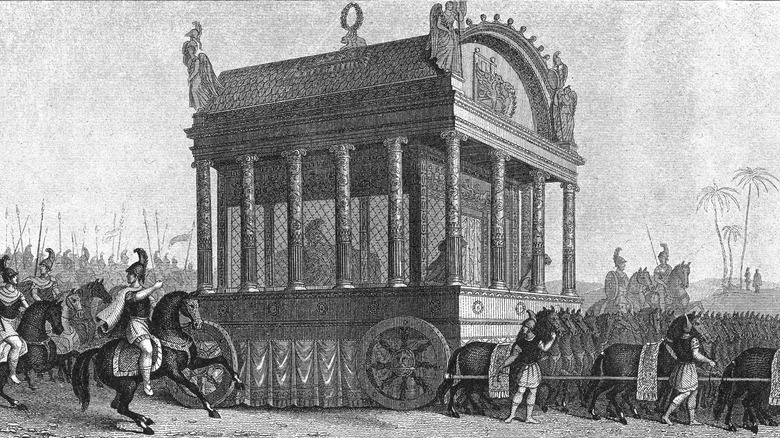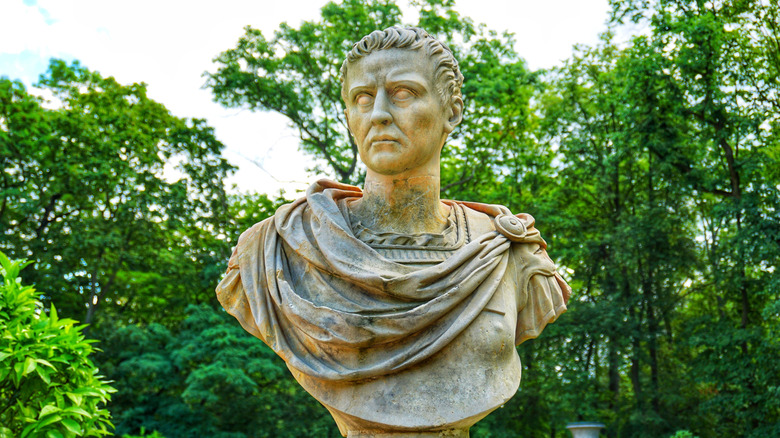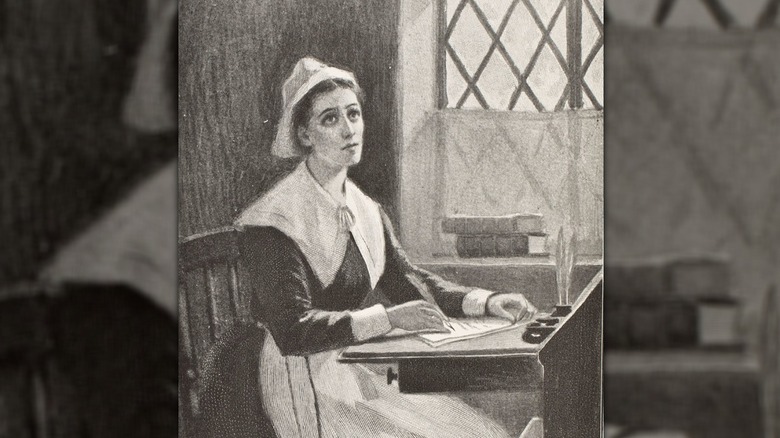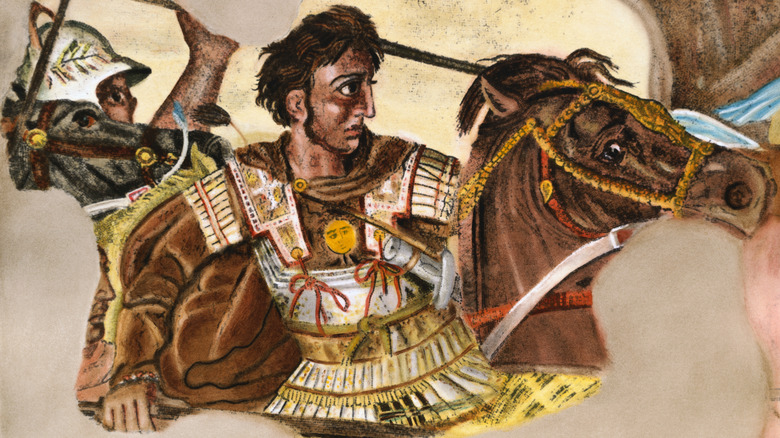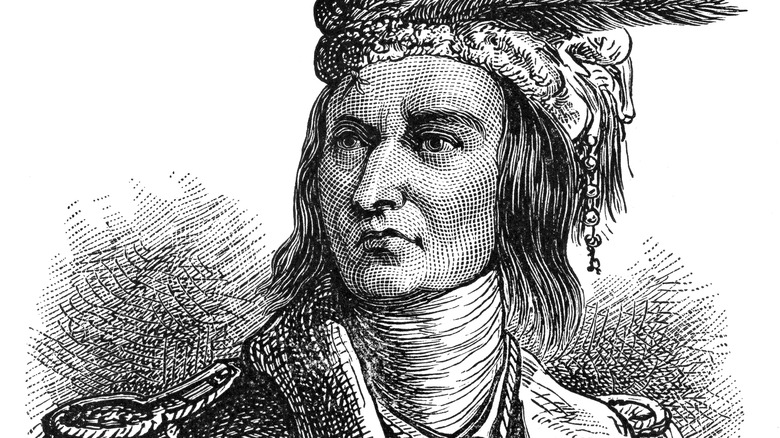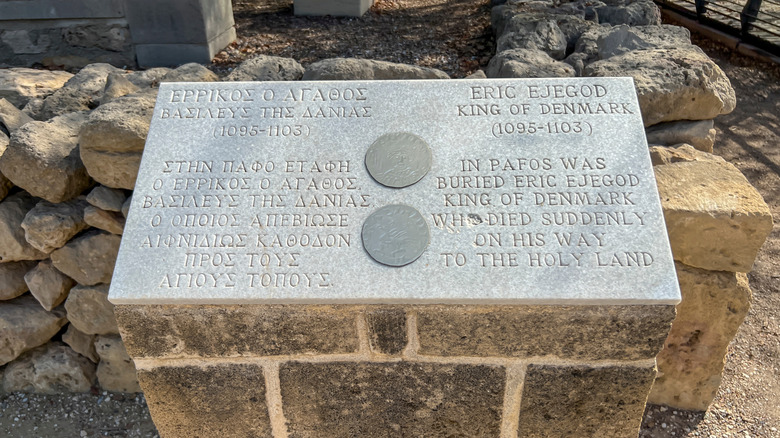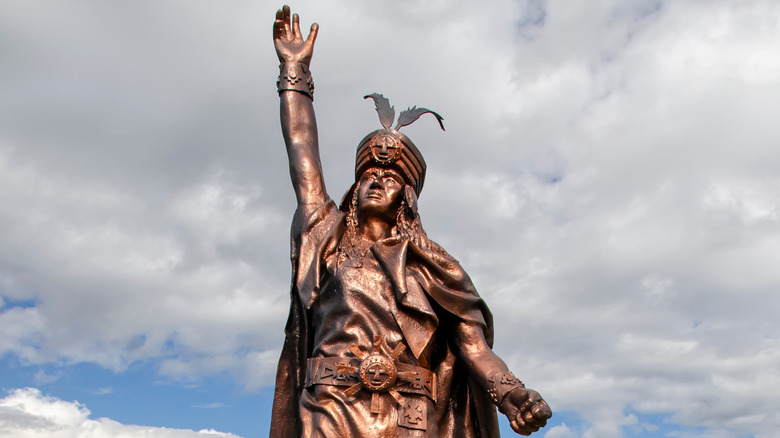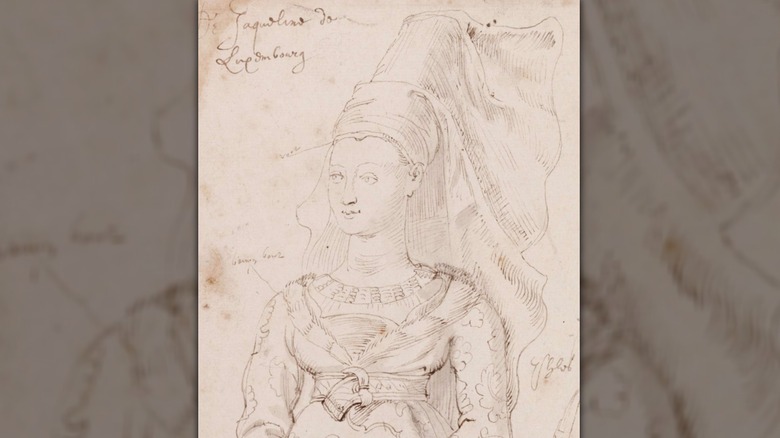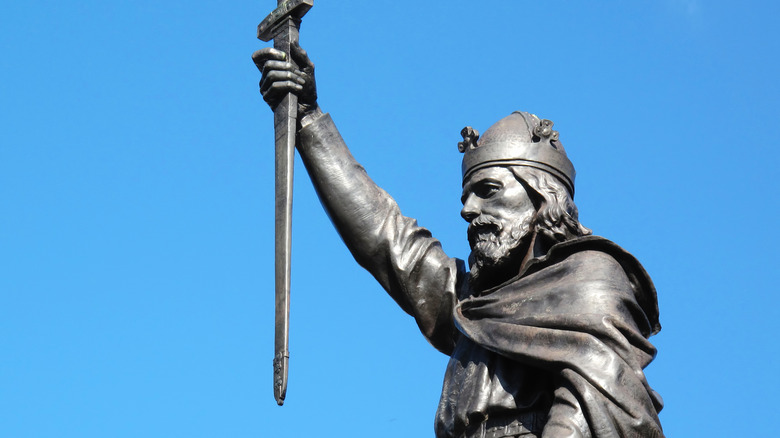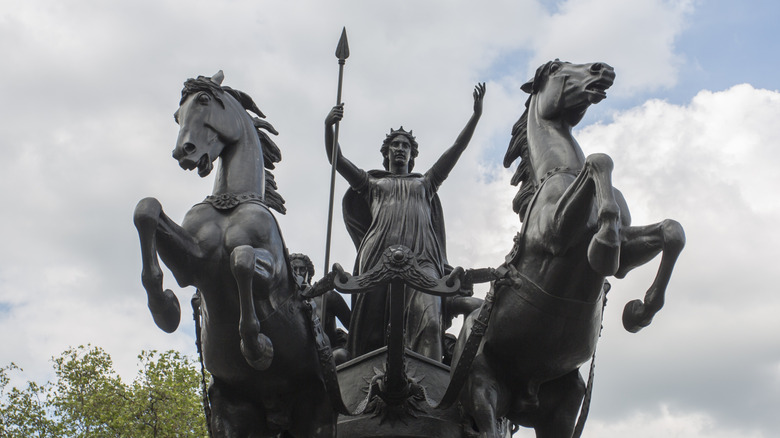Famous Burial Sites That Vanished And Still Haven't Been Found
There are plenty of famous people who are buried in unmarked graves. Maybe they or their families couldn't afford a headstone, or perhaps they didn't want fans (or detractors) from gathering at their gravesite en masse. It's usually not that anyone was trying to hide their graves, although there are some historical examples of that occurring, too. The gravesites of leaders like Genghis Khan, Attila the Hun, and Kamehameha I of Hawaii were purposely obscured from the beginning for cultural and religious reasons, so no one knows where they were buried.
But then there are the notable people from history who had everything from regular burials to huge funeral processions before being interred in massive tombs. No one was trying to keep their final resting place secret, and mourners visited for years. Then, somehow, the graves just disappeared. It may sound impossible, but there are actually a few post-mortem homes of important historical figures that got misplaced, which historians, archeologists, and regular people are still looking for today. While there are possibilities or good leads on some of them, none of them have been confirmed. Here are the famous burial sites that vanished and still haven't been found.
Caligula
Despite being known to history by his adorable nickname (it means "little boot"), Caligula was one of the most devious Roman emperors in history. He was unpopular, mentally unwell, and sadistically cruel. Considering the track record of the empire he ruled, it should come as no surprise that the infamous Roman emperor was assassinated around age 28 or 29 in A.D. 41.
Since he met such an ignoble end, there weren't a lot of people in the empire who were worried about respecting his remains. According to one ancient source, after his murder, Caligula's body was partially burned and then buried in a shallow grave. Eventually, his exiled sisters were allowed to return to Rome, at which point they dug up his body and cremated it properly. There are theories – but no proof – that his ashes were then interred in the Mausoleum of Augustus, a relative of the family.
Then in 2011, Italian police announced they had discovered Caligula's final resting place completely by accident, after arresting a man who was transporting an ancient Roman statue of a man made of rare marble. They concluded it must be Caligula because he was wearing the right kind of boots, and the tomb the statue came from was near one of the emperor's country homes. But actual historians rubbished this "evidence." Why, for instance, would a hated and assassinated emperor get a nice tomb with a fancy statue? So, for now at least, his true gravesite remains a mystery.
Anne Bradstreet
You probably didn't learn about Anne Bradstreet in your U.S. history class, and that would be a shame. "Even though we don't know much about her, she was a household name in the 17th century, both here and in England," Professor Christy Pottroff told Mass Live. In 1650, she published a book of poetry, "The Tenth Muse Lately Sprung Up in America." This made her the first writer living in the North American colonies to be published, and the book was hugely successful. Outside of her own achievements, she was also well-connected, with both her father and husband serving as governor of the Massachusetts colony.
Yet somehow this famous Puritan's grave was lost. Since 2018, a group of students and faculty at Merrimack College have been actively searching for her gravesite in the "Finding Anne Bradstreet" project. It is believed she is buried either in North Andover or Salem, Massachusetts. In lieu of knowing the actual location, in 2000, a memorial headstone was erected in her honor at one of the possibilities, the Old North Parish Burying Ground, and as of 2024, there was a proposal to erect a statue as well.
It's not just her grave that historians have been searching for. There were also questions about where she lived in North Andover, but in 2024, after a four-year search, two academics believe they can prove the location of two of her homes. This shows that these discoveries are possible and gives hope to the chances of finding her final resting place.
Alexander the Great
Alexander the Great did not do things by halves. So when he died aged just 32 in 323 B.C., his funeral had to be epic. Fortunately, he died in Babylon, far away from his native Macedon, which meant his body was mummified and displayed there before being transported home in a massive funeral procession. Or it would have been, had his friend Ptolemy not hijacked the procession and taken Alexander's body to Egypt.
There, it is believed that Alexander was first entombed in Memphis, in a borrowed mausoleum that was sufficiently grand. While he was interred there, Alexander's successor, Perdiccas, invaded Egypt in an attempt to carry off his body, but was defeated. Meanwhile, Ptolemy prepared at least one elaborate tomb for his old friend in Alexandria (there is limited evidence there might have been two different ones in that city). Called the Soma, it was at a major crossroads of the city and many Roman emperors came to pay homage there, the last recorded visit by one occurring in A.D. 215. However, Alexander's tomb was also repeatedly robbed and damaged by natural disasters.
By A.D. 400, according to some ancient sources, no one knew where his tomb was, not even those living in Alexandria. While some other sources claim to have seen the tomb after this date, they gave no information on where it was located, and at some point it was definitely lost to history. To this day, no one knows what happened to the body of Alexander the Great.
Tecumseh
Tecumseh was a Native American Shawnee chief and warrior who fought against the western expansion of United States colonizers in the early 19th century. Because of this, he chose what must have seemed the lesser of two evils and sided with the British during the War of 1812. Tragically, Tecumseh was slain at the Battle of the Thames, and Tecumseh's death changed Native American history forever.
After his death, Tecumseh's body was mutilated by American soldiers. What happened after that is a mystery, and there are many conflicting accounts of what happened to his body. The stories are mostly similar, with slight variations. Tecumseh's remains were said to be taken by either the Shawnee or the British/Canadians and buried within a few miles of the battlefield. The stories include various markers, like a certain number of specific trees over or next to the grave, sometimes carved with a sign like an image of a turtle or the number of men that Tecumseh killed.
However, if you want to visit the grave of Tecumseh, you can. Or at least, a grave some say contains his body. In 1840, a man claimed to have dug up Tecumseh's remains from the battlefield and those bones are now in a cairn on Walpole Island, with a plaque stating they are those of the Shawnee warrior. The only problem is that there is absolutely no proof the remains were those of Tecumseh. In fact, it wasn't even a single body the man dug up, but bones from several graves on the battlefield.
Eric I of Denmark
Eric I of Denmark, also known as "Eric the Good," was king of Denmark for eight years during the Middle Ages. Despite ruling for such a short amount of time, he managed to fit in a lot of traveling, during which he met the rulers of Greece and Rome as well as several other kings. Then he decided to go even bigger and make a pilgrimage to the Holy Land. This involved a stop in Cypress, where he died in 1103. Rather than try to transport Eric's body back across Europe, he was buried on the island.
While medieval records indicate that the king was buried in Paphos, no one is sure where. In 2007, the island's Antiquities Department explained that because there is so little information available, finding his burial site is probably impossible. However, there is a memorial (pictured) that was erected in 2002.
This random connection between Denmark and Cyprus has formed an unexpected bond between the two nations. Eric I is the only Danish ruler not buried in their home country, so there is a soft spot for the land of his final resting place. And Cyprus seems to feel the same, naming a Paphos street in honor of the foreign king in 2008. A few months prior, the Danish Education Minister Bertel Haarder said, "Whether we find Eric's remnants or not, there is no doubt that he died here and this shows that the good relations between our two countries started 900 years ago" (via Cypress Mail).
Atahualpa
In 1532, Atahualpa was riding high after winning a devastating civil war against his half-brother for control of the Incan Empire. But he would never get to celebrate his victory since, almost immediately afterward, Francisco Pizzaro invaded the capital of Cuzco. When Atahualpa refused to convert to Catholicism and submit to the king of Spain, Pizzaro unleashed a slaughter. Captured, the emperor tried to bribe his way out of it with riches, but the Spaniard just took the treasure and then executed him anyway.
Faced with death, Atahualpa this time agreed to convert to Catholicism — not because he had suddenly found their particular version of religion, but because Pizzaro agreed that if the emperor did then he could be strangled instead of burned at the stake.
The Spanish allegedly buried Atahualpa under the public square where he was killed, but there is evidence his body was moved by his people. Because the next Incan emperor needed to be crowned in the presence of his predecessor's remains, it would have been vital for the continuation of the monarchy that Atahualpa's body be recovered. The Spanish thought the Incas were trying to covertly move gold and silver to nearby caves, but it could actually have been the corpse. One important but controversial theory, based on something in the will of Atahualpa's son, is that his body was brought to Maiqui-Machay, although archeologists disagree about the most likely location and extensive archeological digs have yet to uncover any evidence.
Jacquetta of Luxembourg
Jacquetta of Luxembourg was the daughter of the ruler of Luxembourg, but became the second most important woman in England thanks to her marriage and family connections. She became Duchess of Bedford when she married a brother of England's Henry V. Even though she was widowed after less than two years when she was just 19, Jacquetta was left a lot of money in his will, which allowed her to pretty much do what she wanted. Her second marriage — for love and to someone considered socially beneath her — was controversial but successful, resulting in 14 children. One of them, Elizabeth Woodville, would go on to be Queen Consort to Edward IV.
Despite Jacquetta's extensive connections to the monarchy and personal fortune, her life wasn't completely happy. She was living right smack in the middle of the War of the Roses, which meant the power in England swung back and forth between her family and her enemies. In 1469, she was accused of using witchcraft to make sure her daughter married the future king. These accusations were taken seriously, and she was detained and evidence brought against her, including small lead figures allegedly used as part of a magic ritual. She reached out to the mayor of London to help her defense and was eventually released.
Jacquetta died in 1472. Historians have so far been unable to find any documents that say where she was buried, and no known grave or tomb exists, although some theorize it was where she lived, in Grafton Regis.
Alfred the Great
Alfred the Great was King of Wessex, perhaps most notable for being the first king to rule over "all" the English. But he seems to have moved around almost as much after death as he did during his lifetime. After the mysterious death of Alfred the Great in A.D. 899, the body of this famous Anglo-Saxon king of England was first buried at the Minster (a big church) in the capital of Wessex, Winchester. There was already a new, nicer church being built, though, so when it was finished a few years later, his body was moved from what was now called the Old Minster to the New Minster.
That would not be his last resting place, though, not even close. In 1110, the monks of the New Minster decided there were too many problems there – including the neighboring monks of the Old Minster — and moved to Hyde Abbey, bringing Alfred's remains with them. There they supposedly laid until 1538, when Hyde Abbey was shut down, along with most other monasteries, during Henry VIII's rejection of Catholicism so he could marry Anne Boleyn. During this period, Alfred's grave was robbed and his bones may have been put on display.
It was thought Alfred's remains were eventually moved to St. Bartholomew Church, but tests on what were believed to be his bones showed they were from hundreds of years later. A piece of hip bone found at Hyde Abbey in 1999 is at least from the right era, and might be Alfred's or his son's. As for his final resting place, though, no one knows for sure.
Boudicca
Boudicca was queen of the Iceni, a tribe in what is now England, during the period when the ancient Romans were invading the island. Thanks to the ongoing conflict that resulted, the Celtic warrior queen Boudicca had a crazy life and crazier death. While she is celebrated in Britain today (including with a large statue on the Thames near Parliament, pictured), no one knows where her remains ended up.
The ancient historian Cassius Dio wrote that she was given an expensive burial by her people, so if his information is accurate she must have had a noticeable grave site, or at least one that continued to be a culturally important location for some time. Yet no information regarding the location has survived to modern times, and some historians think that any form of elaborate burial would have been unlikely because of her tribe's customs. However, that hasn't stopped people from guessing, and it seems half the places in England are believed to be where the Iceni queen was buried, sometime after her defeat by the ancient Romans in A.D. 60 or 61.
Just some of the locations that historians have posited as possibilities — though few have any real evidence attached to the guess — are under Stonehenge, in Birmingham, in Gloucestershire, or in Norfolk. London is another possibility, although no one can agree on where in the city her grave could be, with guesses ranging from underneath King's Cross Station to Hampstead Heath to Peckham Rye.
Leonardo da Vinci
Leonardo di Vinci was the quintessential Renaissance Man, seemingly talented at any craft he turned his hand to, from art to engineering to architecture. Famous even in his own lifetime, rulers clamored to have him visit their kingdoms. This meant that even though Leonardo was Italian, he was in France when he died, and it is even possible the king of France was with Leonardo as he passed. According to the painter's own wishes, he was buried at the nearby Château d'Amboise.
During the French Revolution and again during the Napoleonic years, the church at Amboise was damaged and demolished, and the bones of many buried there were dug up and scattered. Then, in 1863, someone picked up some bones that might have been Leonardo's and they were reburied at the Chapel of Saint-Hubert. However, there is no actual proof the right remains were selected. Despite this, the remains can be seen today under a large marble tomb bearing Leonardo's name. It is only on a nearby plaque that visitors learn they are only "presumed" to be his.
As of 2025, there is an ongoing project to find indirect descendants of Leonardo to determine if the bones are actually his. This involves obtaining DNA from his paintings, a lock of hair, and from the bones, and then tracing his family tree. While the effort has been years in the making, they have not announced any conclusive findings as of this writing, so Leonardo's final resting place remains a mystery.
